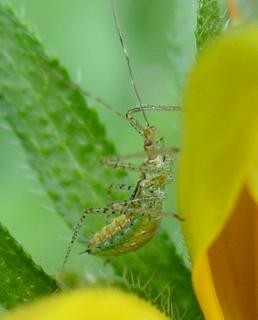 Curious people will ask, What is that bug? And, I've asked the same thing. During my years of experience as a landscape manager and a home gardener I've had plenty of opportunities to see bugs: insects, spiders, worms, snails and so on; but I am by no means an expert. I've always been a bug lover, but often can't identify my small acquaintances by species. In the US alone, there are about 100,000 described insect species, maybe 3500 spiders, over 100 earthworms, etc; so it's not too surprising that all of those I happen to run across aren't in books or on websites.
Curious people will ask, What is that bug? And, I've asked the same thing. During my years of experience as a landscape manager and a home gardener I've had plenty of opportunities to see bugs: insects, spiders, worms, snails and so on; but I am by no means an expert. I've always been a bug lover, but often can't identify my small acquaintances by species. In the US alone, there are about 100,000 described insect species, maybe 3500 spiders, over 100 earthworms, etc; so it's not too surprising that all of those I happen to run across aren't in books or on websites. The bug in this photo was found lurking on a rudbeckia flower in mid-morning. When bothered by my curiousity, it moved slowly away. I guessed it was an assassin bug. This guess was based on my prior observation of assassin bugs lurking in flowers, and their general body shape. Notice the long beak, the thin head, the long legs and antennae, and the curved abdomen: the body shape is the theme of the family Reduviidae, assassin bugs. But I could be wrong. This specimen is immature so it doesn't have wings or the characteristic little triangle on its back where the wings cross as most mature true bugs have. True bugs (as opposed to dirty rotten lying bugs) are of the order Hemiptera, the next larger taxonomic division above Reduviidae. They undergo incomplete metamorphosis, and so they hatch from eggs, gradually grow and shed their exoskeletons several times and finally after the last molt emerge as winged sexually mature adults. The nymphs do not necessarily look like the adults, but often do. If my guess is not completely wild and my bug is a true bug, there's hope: there are only about 5000 known species of true bugs in the US, and with a little luck I should be able to identify this one!
I checked my resources. Insects of the Los Angeles Basin, a basic guide to about 400 local insect species, did not discuss this species. The three reduviidae species included in this excellent book were very much different from my specimen. A local Orange County website has photos of two reduviidae found here which also don't closely resemble my specimen. The helpful naturalists at Bugguide agreed my specimen is an assassin bug, and suggested it is of the pselliopus genus, probably due to its striped legs. But, the adult pselliopus pictured on their site do not resemble the adult assassin bugs I've seen in the environment where my specimen was found. Those adults do look very much like the photos of the adult Zelus genus. Another site had more photos of both genera and so kind of confirmed my feeling that what we are looking at here is a member of the genus Zelus. Whew. So maybe this little fellow or gal is a Zelus. Or a Psellioppus.
Maybe it's enough to know the family and general characteristics of the creature you've encountered. In this case, it's an assassin bug, a general predator that lies in wait for its prey and might bite a meddling human. Add to that my personal experience with the species (has never bit me; hangs out on flowers; I've seen it eating flies; the nymph does not look very much like the adults I've seen in this environment before). I know this species is more useful (eats pests) than pesky (doesn't bother me and doesn't molest plants). So even without knowing its name I can conclude it is beneficial in my gardens and landscapes. But that conclusion is based solely on my experience, and it takes a community of observers to really describe a species in all of its detail. Maybe some kind person out there has more information about this species. Maybe they've been longing for an outlet for their bug information. Maybe they believe information in and of itself is Good, and helps us all become more reliably informed.
I'm sure the Second Great Age of the naturalist is just around the corner, but I have to admit I have only one set of eyes and a real job, and can't see everything even in my own backyard. I'm convinced there is a small army of bug observers in my local community just crawling with information. What if there was a site where troops of this army could post their comments, photos and observations to share with fellow bug people? What if that site eventually logged information such as the emergence dates of important species year to year? What if that site was another resource for some lone local naturalist seeking a name and life history details for an interesting bug? For now, I aim to regularly post observations and photos of bugs found here in my home county. There are well over a million insect species in the world; by limiting my scope I can hope to deepen our pool of knowledge.
Now, I'll go back to obsessing about the identification of this little assassin bug we have here . . . . .
No comments:
Post a Comment